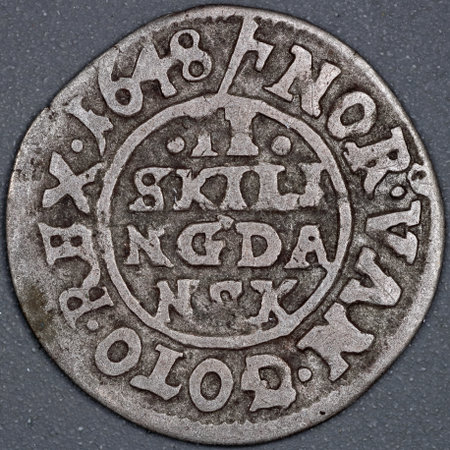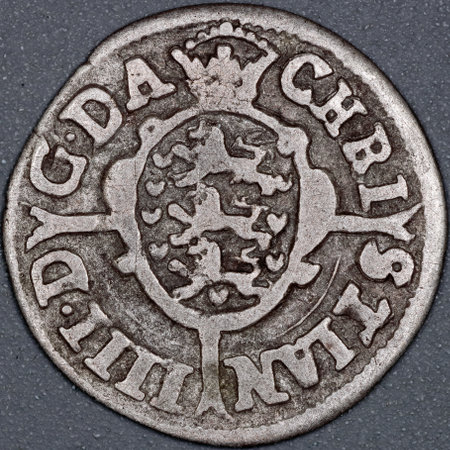| Author |
 Replies: 7,431 / Views: 382,747 Replies: 7,431 / Views: 382,747 |
|
|
|
Pillar of the Community
 Sweden
2079 Posts |
France 1649, 1 denier, Louis XIV, Paris (A).  1649 was the last year for the 1 denier in the royal domain (feudal deniers were minted for a few years more). This the smallest of denominations, 1/240 of a livre, was of little use even as small change.* It was minted only 1648 and 1649 and although minted only in Paris, it did not circulate there, only in the provinces. * 1 denier tournois was about one third of an English farthing (based on the value of gold coins in France and England). Double deniers did circulate, they would be a bit less than a farthing. |
|
Pillar of the Community
 United States
6896 Posts |
More interesting French numismatic history! For the 1640s and late 1630s I will largely depend on Brabant and Livonia. 1649 Duchy of Brabant 1 patagon, Antwerp mint:   Edited by tdziemia
01/26/2021 07:15 am
|
|
Moderator
 United States
32709 Posts |
Here is a Kreuzer from the German Free City of Regensburg dated 1649 AD:   Added: @tdz, I was wondering about the Patagon that you posted today. On the rev, encircling the shield is an arc of eight objects. They kinda look like candy wrappers or wavy belt buckles, but of course aren't Sometimes the letter X on medieval coins has a slightly similar look so I'm wondering if you know what those things are.  "If you climb a good tree, you get a push."
-----Ghanaian proverb
"The danger we all now face is distinguishing between what is authentic and what is performed."
-----King Adz
|
|
Pillar of the Community
 United States
6896 Posts |
I think they are those "briquets" which show up on Brabant and Flanders coins, and which were discussed somewhere on a thread here (maybe 5th edition?). On this coin they are part of a chain holding the Golden Fleece emblem (at 6:00 above the V in DVX) https://en.wikipedia.org/wiki/Briquet_(coin)And I think we will see them intermittently until 1474  For 1649 I also have a twin to @pepactonius' solidus of Swedish Livonia:   Edited by tdziemia
01/26/2021 8:48 pm
|
|
Moderator
 United States
32709 Posts |
Ok yep thx. Either I missed that conversation or it has floated out from my brain. I did find this discussion of briquets here though: http://goccf.com/t/338790Thx for helping me (re)learn something today! "If you climb a good tree, you get a push."
-----Ghanaian proverb
"The danger we all now face is distinguishing between what is authentic and what is performed."
-----King Adz
|
|
Bedrock of the Community
 United States
12041 Posts |
Posting this in 1649 (the last year of issue) since they were not dated. This is a BIG chunk of silver. (1637-1649) 28 Stüber (Gulden) Oldenburg (Jever mint) - Davenport 713 41.2mm and 19.5g  Member ANA - EAC - TNA - SSDC - CCT #890 "Most of the things worth doing in the world had been declared impossible before they were done." -- Louis D. Brandeis |
|
Pillar of the Community
United States
9395 Posts |
1648 -- Kingdom of Denmark, 2 skilling:   |
|
Pillar of the Community
 United States
5995 Posts |
1648 Utrecht Ducat   |
|
Pillar of the Community
 United States
6896 Posts |
@spence, yes that was the thread! 1648 Swedish Livonia, 1/24 thaler (poltorak or dreipolker). While this area was under Swedish rule for much of the 17th century (starting 1621), I find the numismatic situation a bit confusing, with coins issued both as Livonia and City of Riga.   Edited by tdziemia
01/27/2021 07:33 am
|
|
Pillar of the Community
 Sweden
2079 Posts |
Quote:
I find the numismatic situation a bit confusing, with coins issued both as Livonia and City of Riga. I don't collect coins from the Swedish possessions, so my knowledge on the subject is limited. But with the help of some of my Swedish numismatic literature, I think I can shed some light on the situation anyway. The explanation is that there were two mints in Riga: The city mint and the Swedish government mint. The city mint was established in conjunction with the Swedish occupation in 1621 and got rights to mint in accordance with Polish standards. Their coins have inscriptions like Moneta Nova Rigensis. The Swedish government mint was established in 1644, with the express intention of minting debased coins for distribution in Poland. Those coins have inscriptions like Moneta Nova Livoniae. The purpose of spreading debased coins was to attract the better coins from Poland into Livonia, which succeeded to such an extent that the Poles claimed (according to my book, I don't know how true it is) that "Sweden through its miserable coins caused more harm to Poland than through its warfare." Poland protested, the Riga city mint protested, but the Swedish government mint continued its debasement operations. It didn't stop until the 1660s, when the Gospodar (Lord) of Moldau started minting copies of the Riga coins that were even worse than the Swedish ones and thus in turn pushed out the latter.
Edited by erafjel
01/27/2021 1:28 pm
|
|
Pillar of the Community
 United States
6896 Posts |
Very helpful! I was aware that Riga was a "free city," but was not sure how this figured. And the establishment of the Swedish mint in 1644 explains why we see CIVI RIGENSIS coins before this, but also LIVONIAE later. And, as I have acquired some of my Livonian solidi on ebay, I have sometimes wondered if I have gotten any of the Moldavian counterfeits. I think they usually have fictitious dates, and mine are all valid dates, but if anyone out here can detect the counterfeits, I would be glad to know. |
|
Pillar of the Community
Russian Federation
4935 Posts |
Quote:
1649 was the last year for the 1 denier in the royal domain (feudal deniers were minted for a few years more). Neat denier! And I want one of those now, but they're probably rare. I happen to have a low-grade 1651 denier from the feudal domain of Dombes, which was one of my earliest purchases back around 2012; your post reminded me of its existence. Sadly (as far as I could recall) I didn't remember to take photos before it got misplaced. Quote:
The explanation is that there were two mints in Riga: The city mint and the Swedish government mint. TIL! I just thought that (the free city of) Riga was a separate authority from the rest of Livonia and consequently had separate coinage, much like the separate coinages of Danzig (consistently) and Elbing and Torun (occasionally) within Poland itself. I have a coin from Livonia photographed, but it's dated 1645, so wouldn't show up for a few more days. It looked slightly debased, so I thought it was one of the Moldavian (Suceava mint) issues, but it doesn't look that debased, so apparently it's probably real - good to know!
|
|
Moderator
 United States
32709 Posts |
Quote:
The purpose of spreading debased coins was to attract the better coins from Poland into Livonia A good example of Gresham's Law--thx for helping me learn something about late medieval Sweden @era! Here is my brother to @pep's coin for today: a 2 Skilling minted in Denmark and dated 1648 AD:  
"If you climb a good tree, you get a push."
-----Ghanaian proverb
"The danger we all now face is distinguishing between what is authentic and what is performed."
-----King Adz
|
|
Pillar of the Community
 Sweden
2079 Posts |
Quote:
Neat denier! And I want one of those now, but they're probably rare. It is neat, isn't it? And quite affordable and not too hard to come by - there are several available on MA-Shops. Go get one! 
|
|
Pillar of the Community
Russian Federation
4935 Posts |
Quote:
And quite affordable and not too hard to come by - there are several available on MA-Shops. ...I wonder what you mean by "quite affordable". $20? $50? $100? I paid about $3 for the Gaston; for this type (knowing nothing about its rarity) I might be willing to go as high as $10-15 maybe. Accounting for shipping, I doubt that MA-Shops is an option.
|
| |
 Replies: 7,431 / Views: 382,747 Replies: 7,431 / Views: 382,747 |






































